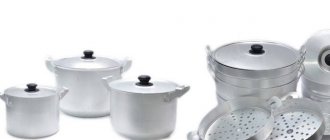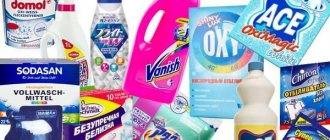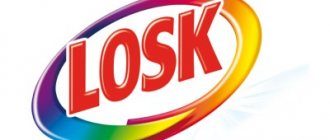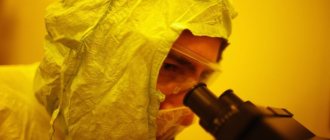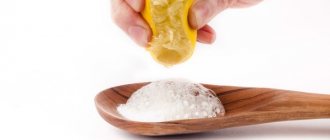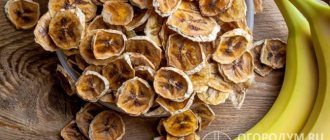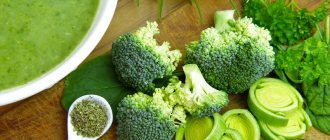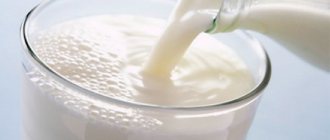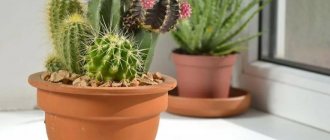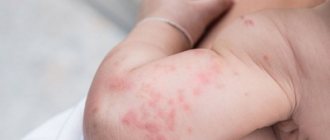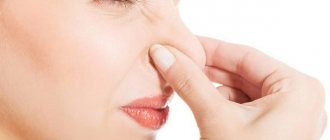Washing is an integral part of our daily life. Usually we don’t even think about what a detergent consists of. And when purchasing, we focus only on the popularity of the brand and the inscriptions on the packaging. But in vain, because the powders can contain things that can make you itch, blush and sneeze. Manufacturers add harmful and dangerous components to many laundry products that can cause skin irritation, allergies and other problems. So, let's look inside the packaging of the powder and find out what zeolites do in washing powder, the harm and benefits of surfactants, phosphates and phosphonates.
What substances are dangerous for septic tanks
Any substances that cause a bactericidal or bacteriostatic effect are dangerous for septic tanks. They come into wastewater from household chemicals, especially disinfectants.
The most common disinfectants are chlorine-containing substances: hypochlorite, chloramine, chlorine dioxide, which are added to products such as Belizna, Domestos and others. They cause rapid inhibition of the vital activity of bacteria, both aerobic and anaerobic, and take local treatment facilities out of operation.
The following cannot be poured into a septic tank:
- Chlorine- and acid-containing disinfectants;
- Hydrogen peroxide solutions, as well as bleaches, including additives (sodium perborate and percarbonates in some laundry detergents);
- Alcohol-containing disinfectants;
- Iodine-containing and other bactericidal preparations.
All substances harmful to microflora are considered unacceptable. It is possible to disable a local sewage system by dumping even large quantities of broad-spectrum antibiotics into it, however, such experiments are unlikely to be of interest to anyone. But plumbing products with bactericidal compounds are sold everywhere.
Consider the composition of popular powders
As an example, I propose to consider some products of the German concert Henkel (brands - Persil, Laska, Losk, Deni, Pemos), which holds a large share of the Russian washing powder market - 26 percent. And the Persil brand is the leader of preference for about a third of Russians.
I highlight the definitely dangerous substances in red and the moderately harmful ones in orange.
Persil Expert:
- 5-15% anionic surfactants,
- oxygenated bleach;
- less than 5% nonionic surfactants,
- polycarboxylates,
- phosphonates,
- soap,
- optical brightener,
- enzymes,
- fragrance (including linaool, benzyl salicylate, hexyl cinnamal)
Washing powder “Mountain Lake”, Losk 9:
- 5% - 15% anionic surfactants,
- oxygenated bleach;
- <5% nonionic surfactants,
- phosphonates,
- polycarboxylates,
- enzymes,
- optical brightener,
- fragrance
Pemos “Oxygen Crystals”:
- 5-15% anionic surfactants;
- less than 5% nonionic surfactants,
- oxygenated bleach,
- polycarboxylates,
- soap,
- enzymes,
- optical brightener,
- fragrance (including butylphenylmethylpropional)
As you can see, the composition of these powders is more or less the same. All of them contain anionic surfactants and fragrance, almost all of them contain phosphonates and optical brightener. Thank the creator, at least there is no chlorine in them!
Now let's look at other powders, the composition of which is of the greatest interest on the Internet:
Myth 3 in 1 Frosty freshness:
- 5-15% anionic surfactants,
- less than 5% nonionic surfactants,
- polycarboxylates,
- zeolites,
- enzymes,
- optical brighteners,
- flavoring additives,
- hexylcinnamaldehyde,
- linalool (it's a fragrance, but it's safe)
Amway Premium:
- 15%-30% Nonionic surfactants,
- 5%-15% oxygen bleach,
- lemon acid,
- polycarboxylate,
- <5% phosphonates,
- optical brightener,
- enzyme,
- fragrance
Ariel "Mountain Spring":
- 5-15% anionic surfactants,
- oxygen-containing bleaches;
- less than 5% nonionic surfactants,
- phosphonates,
- polycarboxylates;
- enzymes,
- optical brighteners,
- flavoring additives.
Here the picture is approximately the same. I’m glad that users of these powders are at least looking for information on the Internet! Amway powder stands out a little - they put few phosphonates there and did not use A-surfactants.
What will happen to the septic tank if you use aggressive household chemicals?
A gradual suppression of the vital activity of bacterial colonies in the septic tank will begin. This will cause a deterioration in the quality of wastewater treatment, and in the future it will stop altogether, and the appearance of an unpleasant odor.
If we are talking about aeration installations, a similar process will look like this: the effluent at the outlet of the system, which was previously transparent, will gradually acquire noticeable turbidity and begin to smell unpleasant. Foam and crust from unprocessed organic contaminants, as well as particles of dead activated sludge (colonies of aerobic bacteria), will begin to accumulate in the chambers.
To avoid this, it is necessary to use safe detergents that do not contain aggressive bactericidal substances in their composition.
Types of phosphate-free powders
There are many options on the market for safe, eco-friendly, phosphorus-free cleaning products. The main ones are presented in the table:
| Name (manufacturer) | Compound | pros | Minuses |
| Galinka (Ukraine) | Sulfates | A universal and cheap product for automatic and hand washing | Chemical surfactants |
| "Karapuz" (Russia) | Silicates, palm soap | Due to palm soap it gives a thick foam | Harmful silicates (zeolites) |
| Burti (Germany) | Phosphonates | Used for children's things if the child is not prone to allergies | High price |
| Deni (Russia) | Oxygen bleach, natural soap | Universal detergent for washing baby clothes | Strong smell |
| “Our Mother” (Russia) | Natural soap, enzymes | Available in the form of economical soap shavings, which are pre-diluted in water | Not suitable for hand washing |
| Klar Eco Sensitive (Germany) | Soap nut, coconut soap | Recommended for allergy sufferers, used from the first days of life | Expensive |
| Organic natural (Russia) | Baby soap, soda, fatty acid salts | Contains no chemicals, only natural surfactants | Poor cleaning properties |
What are washing powders, dish detergents, shampoos made of, and are they dangerous for septic tanks?
Main components of detergents:
- Surfactant
- Additives for water softening
- Fillers
- Bleaches
- Enzymes
Surfactants are the main and most complex group of additives
The abbreviation surfactant stands for “surfactants”. They are found in any detergent. No “environmental products without surfactants” exist and cannot exist in nature; these are nothing more than illiterate marketing ploys.
Actually, even ordinary soap, which is made from natural fats and consisting of sodium or potassium salts of higher carboxylic acids, is a surfactant.
The basis of surfactants are special molecules that have so-called hydrophobic heads that interact with water, and a hydrophilic tail that does not interact with water, but adheres well to various types of contaminants, including fats.
Such molecules, when they meet fat droplets in water, form micelles - structures where the molecules are directed with their heads outward, towards the water, and with their tails towards fatty, water-insoluble contaminants. Next, the micelles are washed off with water.
There are four types of surfactants in detergents:
- Anion Anions are negatively charged ions. Accordingly, this type of surfactant forms negatively charged particles with a complex molecular structure in water. They have very good cleaning properties and foam perfectly. Usually represented by substances such as sodium laureth sulfate, tetrasodium laureth sulfate, etc. Biodegradability depends on the specific substance.
- Cationic A cation is a positively charged ion. Accordingly, such surfactants form particles with a positive charge in water. They do not have the best cleaning properties; they are often used against electrification, as antistatic agents. A typical example is such additives as benzyl trimethyl ammonium, cetrimonium chloride. This type of surfactant, among other things, has a fairly high bactericidal activity and is harmful to bacteria in septic tanks!
- Amphoteric surfactants This is an unusual type of surfactant, the behavior of which is determined by the pH value of the water. They can exhibit the properties of both cationic surfactants, at acidic values, and anionic, at alkaline values. They are quite mild, often found in expensive shampoos, and are good if you have sensitive skin due to their delicate effect. They have a high level of biodegradability. Typical representatives: cocamidopropyl betaine, disodium cocoamphodiacetate.
- Nonionic surfactants The safest surfactants, do not form ions in water. They do not have very high foaming, but satisfactory cleaning properties. They are almost completely biodegradable. Most often in the composition you can find neonol, nonoxynol-9.
Water softening additives - phosphates/phosphonates
Designed to soften water. Everywhere you can read stories about their harm and irritating properties. In fact, phosphates are often used in water filters and are not toxic at all. However, in powders they are replaced by phosphonates.
The fact is that phosphates (most often sodium tripolyphosphate) cause the explosive growth of blue-green algae in water bodies, which ultimately, displacing all other forms of life, lead to its rotting. To achieve an effect similar to phosphates, many times less phosphates are required, and accordingly, the harm caused to the environment is also less.
Phosphonates may or may not be toxic. Those present in detergents are non-toxic.
Both phosphates and phosphonates are a nutrient component for activated sludge in a septic tank, being rich in phosphorus. But in excess, they can cause the growth of algae, especially in clean water chambers, since at high concentrations they are not completely processed by activated sludge.
Other substances, such as zeolites, can also be used to soften water. Despite their safety for water bodies, they have a number of very serious disadvantages. Unlike phosphates and phosphonates, zeolites are insoluble and accumulate in tissue. There are known cases of allergic reactions to laundry after washing with zeolite washing powders.
Fillers
In liquid detergents, this is ordinary water. In powders, fillers are usually sodium sulfate and other chemically inert salts.
Bleaches
Used in washing powders. Most often they are represented by a substance such as sodium perborate. It has a fairly high bactericidal activity, which is undesirable for a septic tank.
Enzymes
They are used in washing powders/washing gels and are designed to remove protein contaminants, fats, and oils. They are unstable and destroyed at temperatures of about 40 degrees and above. Typical representatives of this group in the composition are alkaline protease, alkaline lipase, amylase.
Fragrance, dyes
There are both non-natural origin and plant-based, for example, kumquat extract.
Conclusion:
Thus, the main undesirable substances in washing powders and dishwashing detergents when used with a septic tank are:
- Cationic surfactants and bleaches due to their bactericidal properties;
- Phosphate-containing powders, due to the high concentration of the latter and the possibility of algae growth in purified water chambers and places where wastewater is discharged from a septic tank.
About the dangers of phosphates: myths and reality
The use of this group of substances is prohibited by law in many countries - this indicates the scale of the problem. At the same time, the use of phosphates in the food industry is clear evidence of an exaggeration of the problem. Let's try to debunk existing myths.
Myth No. 1 “Deadly health hazard”
With the help of dubious journalists, phosphates from clothing have acquired the ability to penetrate the brain and bones, accumulating and killing the careless consumer. In fact, the likelihood of finding E451 (tripolyphosphate) in condensed milk is higher than on human skin, where it was infiltrated from dried laundry.
Myth No. 2 “Phosphates only soften water; you can easily do without them”
In fact, it is due to them that the powder copes with dirt at low temperatures, prevents the re-absorption of dirt by the fabric, emulsifies and dissolves fats, and neutralizes water hardness. Even simply soaking the laundry in a sodium tripolyphosphate solution will give excellent results.
Myth No. 3 “Allergen of the century”
Household chemicals do cause allergies and dermatological diseases, but phosphorus compounds have nothing to do with it. A person is surrounded by chemistry everywhere, the basis of which is surfactants. Their goal is to reduce the surface tension of any connection, break the bonds, remove everything from the surface. That is, along with dirt, the natural fat barrier of the skin is destroyed, which serves as a provocateur of various skin diseases.
Myth No. 4 “Phosphate-free means safe and environmentally friendly”
The presence of a beautiful green package with the ECO prefix is not a reason to pay double the price. Eco-friendly, natural detergents are made on the basis of plant components, and the surfactants in them are alkanesulfanate and alkylsulfate obtained from coconut or rapeseed oil. The packaging of the antiallergenic product must indicate the use of nonionic substances.
Reality
The world community has sounded the alarm due to waterlogging, which is caused not only by household chemicals, but also by phosphate fertilizers. Against the backdrop of climate change, the loss of fresh water looks much worse than a simple allergy. After going through the cycle from the washing machine to the reservoir, the water will return to the table in a glass or bowl of soup, and then the excess phosphorus will respond to allergies and cancer. It is worth figuring out which powders do not contain phosphates.
Characteristics and advantages of biodegradable detergents
Biodegradability is the ability of compounds to break down under the influence of microorganisms, as well as sunlight, oxygen and other natural influences. This is a very important factor. One way or another, after treatment, all wastewater ends up in water bodies, or, in the case of local sewerage, is discharged into the ground or onto the soil directly on your site.
Biodegradable detergents should use natural or easily biodegradable ingredients. The perfect example here is soap. But, unfortunately, in hard water, soap forms insoluble magnesium and calcium salts, which settle on the skin, hair, and clothes, causing irritation and dryness. And the effectiveness of soap for washing is not very high.
Modern surfactant-based products can be environmentally friendly and at the same time effectively perform the functions of softening water, removing contaminants, and even have a beneficial effect on the skin of the hands.
An example is compositions for dishes with the addition of vitamins and microelements, which restore the barrier function of the skin and protect it from leaching out useful substances.
Why are phosphates dangerous?
Since phosphates are not completely washed out of fabric fibers, this can lead to allergies.
Surfactant is an indispensable part of the powder product. There are many natural types that are environmentally friendly and safe. Derivatives of phosphorus salts are used to enhance the effect of surfactants responsible for the effectiveness of the powder, but these ingredients are dangerous for people. Even a single wash results in phosphate derivatives remaining in the fabric fibers. It is impossible to rinse them out. When contacting the skin, aggressive chemicals cause allergic reactions: itching, hives, swelling.
When you constantly wear clothes washed with a product containing phosphorus salts, the chemical is absorbed into the bloodstream.
This leads to metabolic disorders and can cause cancer, as the substance is a carcinogen. In asthmatics, contact with tissue on which parts of chemical elements remain causes severe attacks of the disease and even status asthmaticus. For these reasons, powders with phosphorus salts are prohibited in many countries. Some European countries (France, Britain) have limited the content of these harmful elements in cleaning products to 12%.
Phosphate compounds are considered the most harmful for the environment because they do not dissolve in water. Their accumulation in natural bodies of water leads to the proliferation of microorganisms and algae. The growth of silt turns clear lakes and rivers into swamps. These changes in the ecosystem are irreparable, since purifying water from pollutants is an expensive and labor-intensive process. Such processes lead to the destruction of animals and plants living in the aquatic environment.
What detergents/cleaning agents and powders can be used in a septic tank?
In terms of composition, the best detergents are those containing a combination of:
- Anionic surfactants, necessarily made from high-quality environmentally friendly raw materials (in this case they are biodegradable);
- Nonionic surfactants are gentle and completely biodegradable;
- Vitamins to neutralize the negative effects of surfactants on the skin;
- Natural fragrances.
Such products will not harm bacteria in the septic tank and will not cause algae growth, and will also be completely safe for humans.
If you choose a bath or toilet cleaner, be sure to ensure that it does not contain chlorine or other bactericidal additives.
Look for the manufacturer's instructions about the possibility of use in conjunction with septic tanks and markings indicating the biodegradability of the product (ECO Safety Certificate, green petal, etc.). It is useful to familiarize yourself with standard certificates of conformity confirming the safe basis of the product, if possible.
Ideally, you should choose detergents without dyes, since they are not always natural and only add biological load without providing any useful function.
Phosphate-free compounds: features of choice
To choose a washing powder that does not contain harmful components, you need to carefully study its composition. This is easy to do both when purchasing in a store and when purchasing the product online.
List of phosphate-free powders:
Cleantown. The product is based on natural ingredients, so its use does not cause skin irritation and does not lead to the development of allergic reactions. Price – 280 rubles.- Attack. This product is from a Japanese manufacturer, does not contain chlorine and phosphates, washes things well and is economical. Price – 480 rubles.
- Bio-Mio . This powder from a Russian manufacturer, which is economically consumed, belongs to the class of biodegradable products and contains natural ingredients. Price – 440 rubles.
A list of phosphate-free washing powders for washing children's clothes is presented in this article.
The composition and purpose of the components of washing powder are discussed in this section.
How to use eco-friendly household products correctly
There are no special features here. Each manufacturer indicates the required amount of powder or liquid detergent. You should follow the instructions. Otherwise, the product, despite its biodegradability, may harm the septic tank.
Do not add conditioners, antistatic agents, or water softeners to the washing machine. They overwhelmingly have an aggressive chemical composition, which will completely negate all the advantages of biodegradable products.
What is their harm to humans?
Phosphates can harm human health. First of all, they pose a danger to the skin, as they disrupt its natural acid-base balance.
This causes:
- dermatitis,
- hives,
- itching,
- rashes and inflammatory reactions.
In addition, regular contact with phosphates poses the following problems:
- Decreased hemoglobin levels in the blood.
- Disorders of the liver and kidneys.
- Increased risk of developing cancer.
- General intoxication of the body.
- Metabolic failure.
Phosphates are especially dangerous for children. Therefore, it is not recommended to use such powders for washing children’s clothes.
It is not for nothing that European countries introduced strict restrictions on the use of phosphates in household chemicals back in 2010.
Requirements for eco-powders
The main requirement is that it must be hypoallergenic. When released into the environment, it quickly disintegrates into components that do not harm the environment and humans.
Ecological detergents:
- Should not contain phosphates and zeolites;
- Quickly decompose by microorganisms;
- Be concentrated, i.e. minimum allowable consumption per wash;
- Wash effectively at 30 degrees, which also reduces energy consumption;
- Does not contain allergens and is suitable for washing children's clothing and people with sensitive skin;
- Have packaging and measuring cup made from recycled paper or other recyclable materials.
Such detergents should not contain:
- Chlorine;
- Aggressive surfactants, EDTA and SLES;
- Chemical dyes, flavors.
The components included in powders from different manufacturers may differ and have pros and cons. Plants that contain saponins, i.e., can be considered completely natural, safe and harmless. soapy substances.
